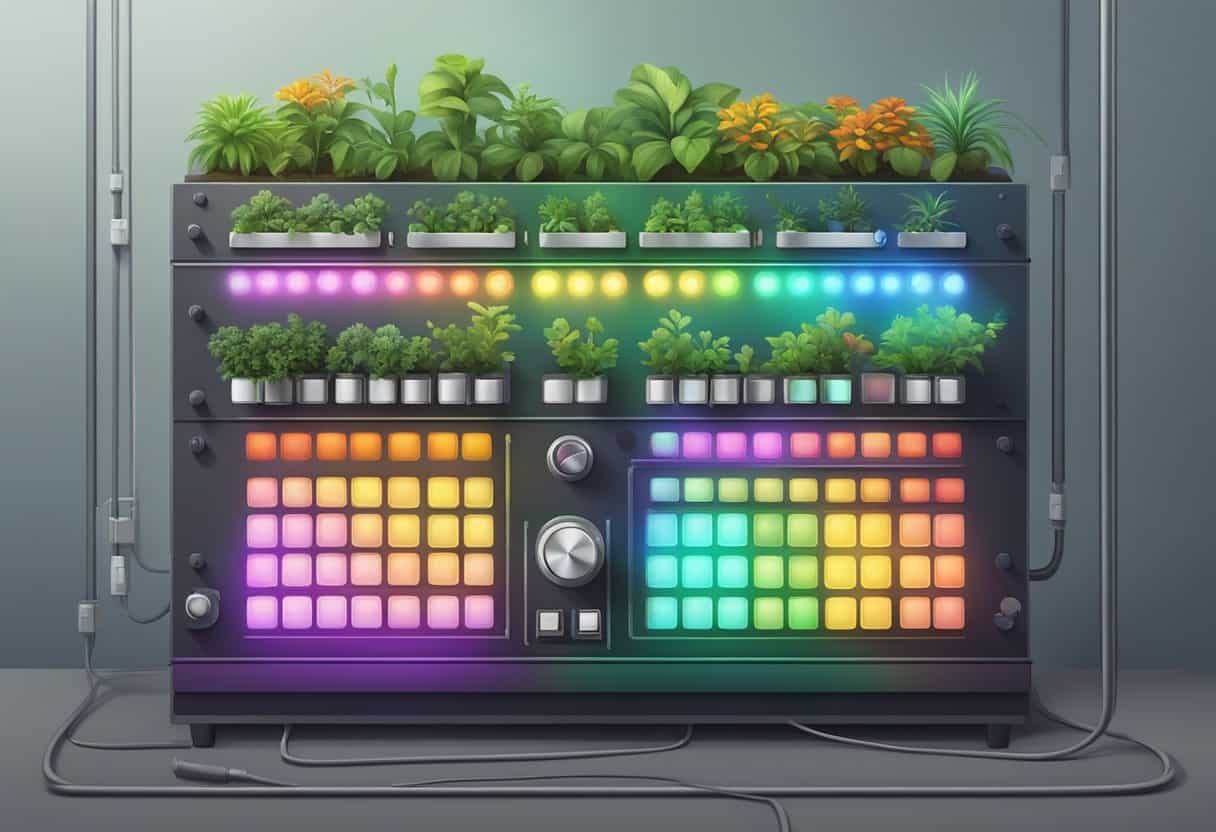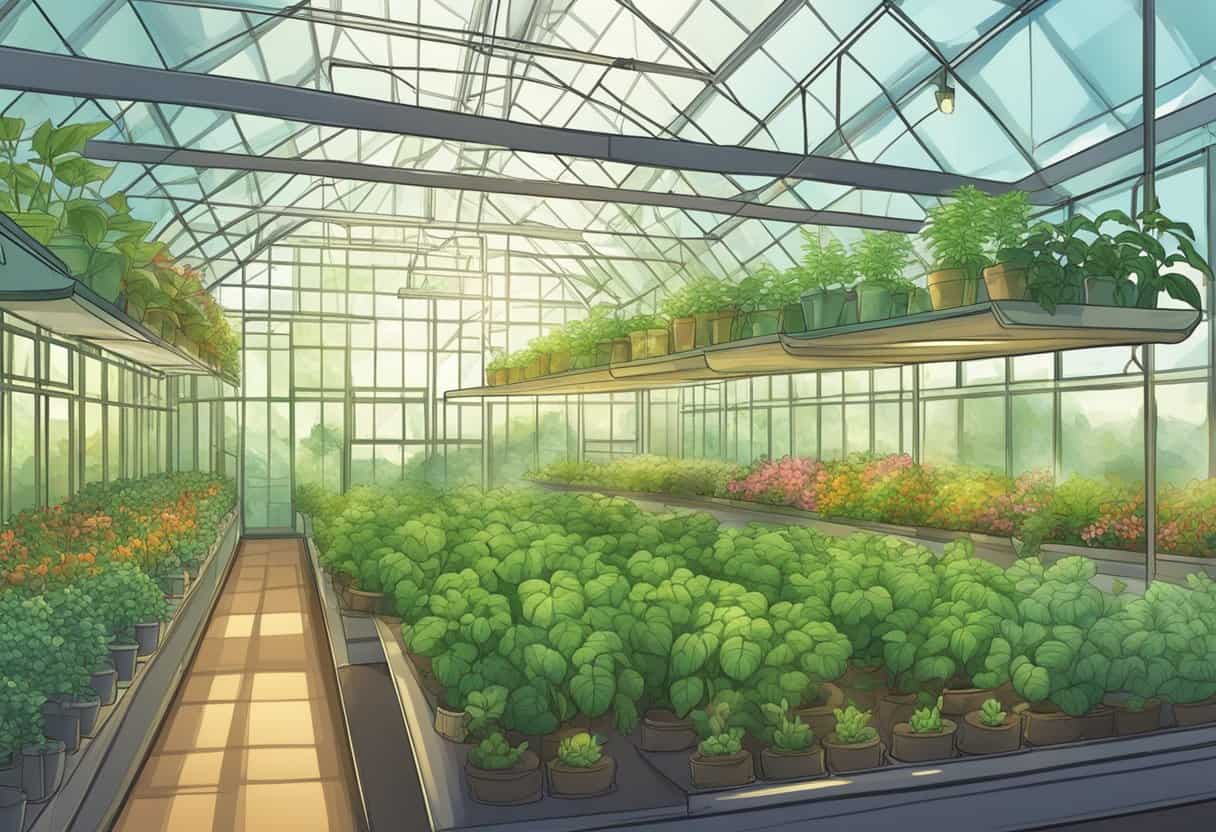In understanding how to optimize plant growth, it’s essential to grasp the intricacies of light and its impact on photosynthesis. This section dissects the relationship between light and plant development, breaking down the science into easy-to-understand concepts.
The Role of Light in Photosynthesis
Photosynthesis is the vital process by which your plants convert light into chemical energy. Chlorophyll, the green pigment in plants, absorbs light predominantly in the blue and red spectrums but less in the green, reflecting it which is why plants appear green to us.
In this process, light energy is used to convert carbon dioxide and water into glucose and oxygen, which are necessary for plant growth and development. Thus, ensuring your plants receive the right quality and intensity of light is foundational to their health and yield.
Understanding PAR and Visible Light Spectrum
Photosynthetically Active Radiation (PAR) refers to the range of light wavelengths that drive photosynthesis, measured in nanometers (nm). The visible light spectrum, a component of PAR, spans from 380 nm to 740 nm, and includes all colors perceivable by the human eye. Each color has a different wavelength and, consequently, a unique effect on plant processes:
- Blue (400-500 nm): Essential for vegetative growth, promoting strong roots and compact plant structure.
- Green (500-600 nm): Less absorbed but plays a role in light penetration through the canopy.
- Red (600-700 nm): Drives flowering and fruiting stages, encouraging reproductive growth.
The Impact of Wavelengths on Plant Development
The carefully balanced spectrum of wavelengths directly influences your plant’s morphology, or shape and structure, and its various growth stages. Blue wavelengths result in shorter, bushier plants, while red wavelengths can lead to taller plants with greater leaf area.
However, it is the combined effect of the complete light spectrum that leads to the best overall plant health and productivity. The use of full-spectrum LED grow lights can mimic the sun’s comprehensive light range and optimize the light environment for your plants throughout their lifecycle.
Grow Light Technologies and Their Spectrums
Understanding the different technologies behind grow lights will help you make informed decisions for your indoor gardening. Each technology offers a unique light spectrum, crucial for plant photosynthesis and growth.
LED Grow Lights: An Overview
LED grow lights, which stand for Light Emitting Diodes, are known for their efficiency and longevity. They can be designed to emit a targeted spectrum of light. Full-spectrum LED lights aim to mimic natural sunlight, providing a range of wavelengths that plants can use throughout their growth stages.
- Light Spectrum: Typically, LED grow lights provide blue and red wavelengths essential for vegetative growth and flowering.
- Variations: Some LEDs also include infrared (IR) and ultraviolet (UV) diodes to offer an even broader spectrum for plant health.
Comparing HID, Fluorescent, and LED Lights
When comparing grow light technologies, consider their light spectrum output and energy usage.
High-Intensity Discharge (HID): These lights, including metal halide and high-pressure sodium (HPS), emit powerful light but can be less energy-efficient and produce more heat.
- Metal Halide: Provides a cooler, blue spectrum, favoring vegetative growth.
- High-Pressure Sodium: Emits a warmer, red spectrum, beneficial for flowering and fruiting.
-
Fluorescent Lights: Common for seedlings and low-light plants, they provide a wide light spectrum but are less intense than HIDs or LEDs.
-
LED Lights: Offer adjustable spectrums and intensity, have lower heat output, and consume less energy, making them a versatile and cost-effective option over time.
Spectrum Variations Among Grow Light Manufacturers
You will find spectrum variations across different manufacturers of LED grow lights. Even within the category of full-spectrum lights, the balance of wavelengths can differ, catering to various plant needs.
-
Full-Spectrum Variations: Some manufacturers formulate their full-spectrum lights to include a wider range of visible light and beyond, including traces of UV and IR.
-
Targeted Solutions: Others focus on providing a targeted spectrum, emphasizing blues and reds at specific wavelengths optimal for particular growth stages.
Manufacturer Spectrum Type Notable Wavelengths A Full-Spectrum 380-780 nm (includes UV & IR) B Targeted 450 nm, 660 nm C Custom User-defined
By choosing the appropriate grow light technology and understanding the spectrum offered by different manufacturers, you can enhance your indoor garden’s performance significantly.
The Specifics of Light Spectrums for Plant Stages

Plants have different lighting needs at various stages of their growth. Understanding the specific wavelengths important for each stage can significantly influence your crop’s development and yield.
Blue Light for Vegetative Growth
During the vegetative growth phase, your plants require blue light, which has a wavelength range between 400-500 nanometers. This light spectrum is crucial for promoting strong leaf growth and is vital for optimizing chlorophyll a absorption. Blue light helps to regulate plant architecture, ensuring sturdy stems and healthy foliage development.
Key Points for Blue Light:
- Wavelength Range: 400-500nm
- Promotes: Leaf growth and strong stems
- Absorption: Optimizes chlorophyll a
Red Light for Flowering and Fruiting
When it’s time for flowering and fruiting, red light becomes critical. Ranging from 620 to 750 nanometers, red light stimulates chlorophyll b absorption, which is essential in these growth stages for the synthesis of flowering signals. Providing sufficient red light can lead to abundant flowering and increase the quantity and quality of fruits.
Key Points for Red Light:
- Wavelength Range: 620-750nm
- Necessary For: Flowering and fruiting stages
- Absorption: Stimulates chlorophyll b
Far-Red and Green Light: Additional Considerations
Your plants can benefit from far-red and green light as well. Far-red light, beyond 700nm, can speed up the flowering process and impact plant architecture when combined with red light. This can result in stretching, which may be controlled depending on your crop’s architectural goals. Green light, generally overlooked, actually penetrates deeper into the canopy and can help in driving photosynthesis where blue and red lights are less effective.
Key Points for Far-Red and Green Light:
- Far-Red (>700nm): Accelerates flowering, affects plant architecture
- Green Light: Penetrates canopy, supports photosynthesis deeper in plant tissue
By tailoring your grow light strategy to these specifics, you can guide your plants through their lifecycle with precision, enhancing both their health and your harvest.
Advanced Grow Light Spectrum Control

Manipulating light spectrums with precision provides you with the power to direct specific growth patterns and optimize your plants’ health. Advanced spectrum control involves fine-tuning light to cater to the unique requirements of different plant species through every stage of development.
Customizing Spectrums for Specific Plant Needs
You have the ability to customize the light spectrum in your grow setup, which is crucial for addressing the diverse needs of your plants. Here’s how to approach it:
- Full-Spectrum Lighting: Mimicking natural sunlight, full-spectrum lighting supports the overall plant development and health. It provides a balanced range of wavelengths suitable for most plant types.
- Tailored Light Recipes: By adjusting ratios of blue, red, green, and far-red light, you can develop customized light recipes. For example, an increase in the blue spectrum can improve leaf development, while red light can enhance flowering and fruiting.
Using Spectrum to Influence Plant Physiology
When you adjust light spectrums, you directly influence plant physiology:
- Shade Avoidance & Phytochromes: Plants detect the ratio of red to far-red light using phytochromes to identify if they are in the shade and initiate shade avoidance responses, like stem elongation.
- Control Over Growth Cycles: By controlling the light spectrum, you can manipulate flowering times or vegetative growth rates to align with your cultivation schedule.
Strategic light spectrum management is a game-changer for indoor growers. Through careful control and customization, you ensure your plants receive the exact type of light needed for any given growth stage, significantly improving plant performance and yield.
Practical Considerations in Grow Light Usage

When using grow lights for indoor gardening or hydroponics, it’s essential to balance the light’s intensity, duration, and distance from the plants while managing energy efficiency and operational costs to ensure optimal plant yield.
Balancing Intensity, Duration, and Distance
Intensity: Your plants require a specific light intensity to thrive, often measured in micromoles per square meter per second (µmol/m²/s). Ensure that the intensity matches the needs of your plants at each growth stage.
- Seedlings/Clones: Lower intensity to prevent damage.
- Vegetative Stage: Moderate to high intensity to promote growth.
- Flowering Stage: High intensity to maximize yield.
Duration: Adequate light exposure, or photoperiod, is key.
- Short-day plants: Require longer dark periods to flower.
- Long-day plants: Need longer light periods to initiate flowering.
- Day-neutral plants: Flower irrespective of the photoperiod.
Distance: Adjust the distance between your lights and plants to find the sweet spot.
- Too close: May cause light burn or excess heat stress.
- Too far: Plants can become leggy as they stretch towards the light source.
Energy Efficiency and Heat Management
- Energy Efficiency: Opt for LED grow lights with high photosynthetically active radiation (PAR) ratings and minimal power consumption to reduce your energy bills.
- Heat Management: Excessive heat can hamper plant growth and lead to water loss or nutrient imbalances.
- Active Cooling: Utilize fans or heat sinks with your grow lights.
- Passive Cooling: Ensure sufficient air circulation around the grow area.
Cost-effectiveness and Operational Costs
- Initial Cost: Evaluate the upfront purchase price of the grow light systems.
- Operational Costs: Factor in the long-term expenses such as electricity usage.
- Yield: A higher upfront cost might justify a higher yield and greater energy savings in the long run.
By adhering to these practical considerations, you can optimize the growing environment for your indoor garden or hydroponic system and achieve a successful harvest.
Understanding Non-Visible Light Spectrum Effects

In the realm of plant growth, non-visible light such as ultraviolet (UV) and infrared (IR) plays critical roles that can profoundly influence plant physiology. This section will examine how these spectral extremes impact your plants and what precautions you should take when incorporating them into your lighting strategy.
Roles of UV and IR Light in Plant Growth
Ultraviolet Light:
- Seedling Development: UV light can stimulate the production of protective compounds in plants, akin to sunscreen, enhancing their vigor and disease resistance from an early stage.
- Reproductive Growth: Exposure to UV light has been linked to improved flavors, colors, and nutrient profiles in plants by prompting secondary metabolite production.
Infrared Light:
- Photoperiod Management: IR light can affect the photoperiod, which is essential for initiating and sustaining a plant’s reproductive growth phase.
- Heat Contribution: Far IR light contributes to the thermal regulation of your plant environment, simulating the warmth plants would receive from the sun.
Spectral Extremes: Benefits and Precautions
Beneficial Impacts:
- UV Light: A controlled amount of UV light can deter pests and mold, while promoting the synthesis of compounds that contribute to the plant’s defensive mechanisms and overall health.
- IR Light: Properly used IR light can accelerate photosynthesis during daylight hours and help maintain the plant’s life cycle rhythms.
Precautions:
- Safety First: Extended exposure to UV can be harmful to both plants and humans, necessitating protective measures such as UV-blocking glasses or shields.
- Balance is Key: IR light should be balanced within your grow light setup to avoid excess heat, which can lead to plant stress or water loss.
By incorporating UV and IR light carefully into your full-spectrum lighting setup, you can enhance your plants’ growth and resilience. Always monitor your plants’ response to adjustments in their light spectrum to ensure optimal results.

